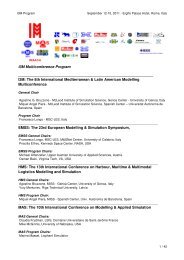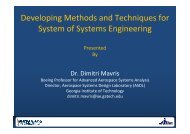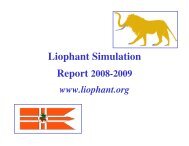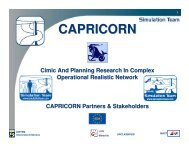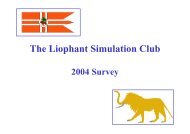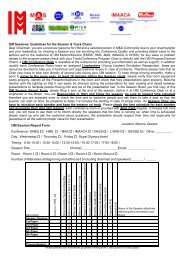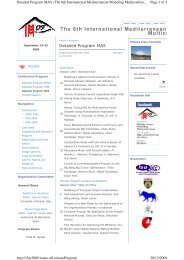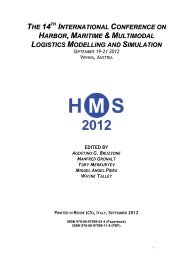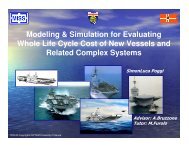HMS2006_F1 - Liophant Simulation
HMS2006_F1 - Liophant Simulation
HMS2006_F1 - Liophant Simulation
Create successful ePaper yourself
Turn your PDF publications into a flip-book with our unique Google optimized e-Paper software.
Figure 1. Areal sight of the dry port in Coslada<br />
The layout of the dry port is shown in the<br />
picture of Figure 1, an aerial sight, where the<br />
physical elements can be identified.<br />
With the only exception of customs control, all<br />
the operations in a dry port are exactly the same<br />
as those in an intermodal inland railway/road<br />
terminal. Following the pattern found in other<br />
similar models, such as in Kulick and Sawyer<br />
(2001) and Rizzoli et al. (2002), the basic<br />
operations modelled were the following:<br />
• Unloading containers arriving to the<br />
terminal in trucks to be transported by<br />
train and, the opposite process, loading<br />
containers in trucks for their final<br />
transportation by truck.<br />
• Loading outbound trains and unloading<br />
inbound trains.<br />
• Customs procedures, in case they have<br />
not been previously done in the<br />
maritime port of origin.<br />
• Container load manipulation in the<br />
consolidation centre, when required.<br />
• Trains arrival and departure.<br />
3. The simulation model features<br />
The objective was to assess whether the<br />
facilities and the current level of resources<br />
could meet the future demand within different<br />
scenarios.<br />
If not, some additional improvements of the<br />
level of resources should be analysed, so that<br />
the future demand could be met with acceptable<br />
levels of efficiency.<br />
The study was twofold, namely, analysing both<br />
the dry port’s effectiveness and efficiency in<br />
the different scenarios. In relation to the<br />
effectiveness, the main indicator was the total<br />
processing time for a container. The total<br />
throughput was of much less importance and<br />
therefore was not considered as a relevant<br />
indicator. However, to obtain a more detailed<br />
assessment of the system, the waiting time of<br />
containers in each operation can be valuable.<br />
With regard to the effectiveness, it was of great<br />
interest to identify potential bottlenecks and<br />
highly underexploited resources. Thus, the<br />
indicator chosen were: the use percentage of<br />
each resource (cranes and labour) and the<br />
average occupation of physical elements (such<br />
as rails and storage area).<br />
The complexity of the system and the stochastic<br />
nature of the processes involved in the dry port<br />
are the common features of those problems<br />
studied through simulation. Discrete event<br />
simulation allows the researcher to create an<br />
off-line model where experiments can be run<br />
instead of doing it in the actual system, and<br />
more importantly, at quite a lower cost.<br />
Among the range of simulation environments,<br />
Witness ® (by Lanner Group) was chosen to<br />
build the model with. Witness® has proved to<br />
be a suitable tool in studies of similar nature in<br />
the past and, actually, it was absolutely<br />
satisfactory for the current one.<br />
When defining the conceptual model, the<br />
authors decided to take a step ahead in<br />
comparison to the previously developed<br />
models. Among the enhancements, those most<br />
worth mentioning are:<br />
• Train length was flexible to some<br />
extent.<br />
• The loading/unloading operations<br />
performed by the gantry crane were<br />
represented in a more realistic way.<br />
Following, according to the information<br />
gathered from the dry port managers, the<br />
assumptions to obtain a valid model of the<br />
system are described.<br />
First, combined transport trains run according<br />
to settled schedules, thus arrival and departure<br />
times were established and available.



